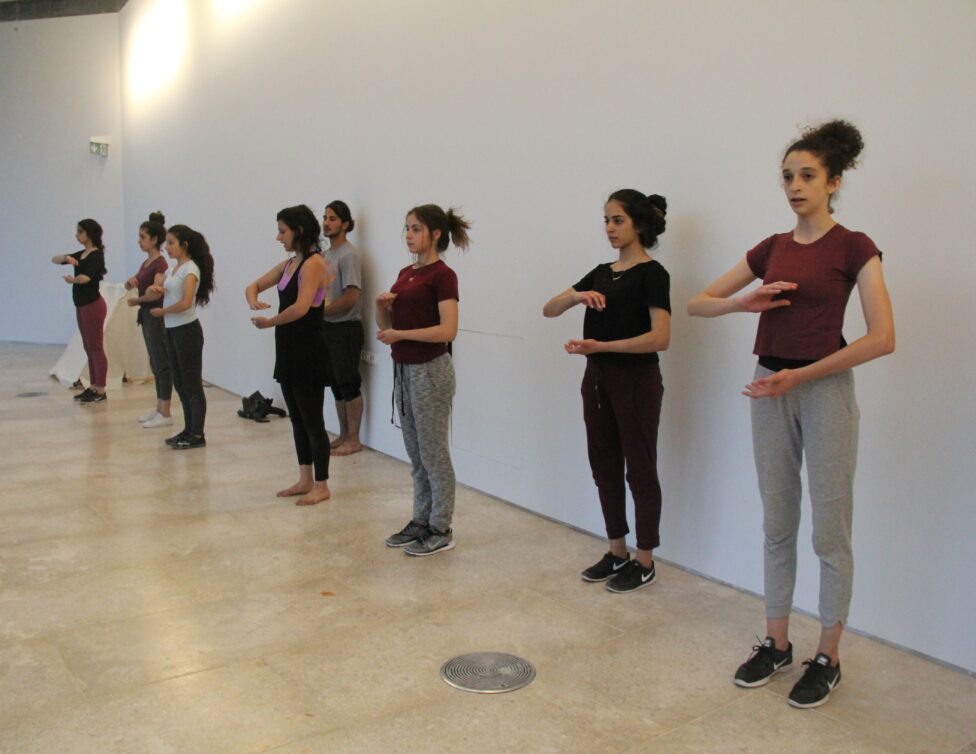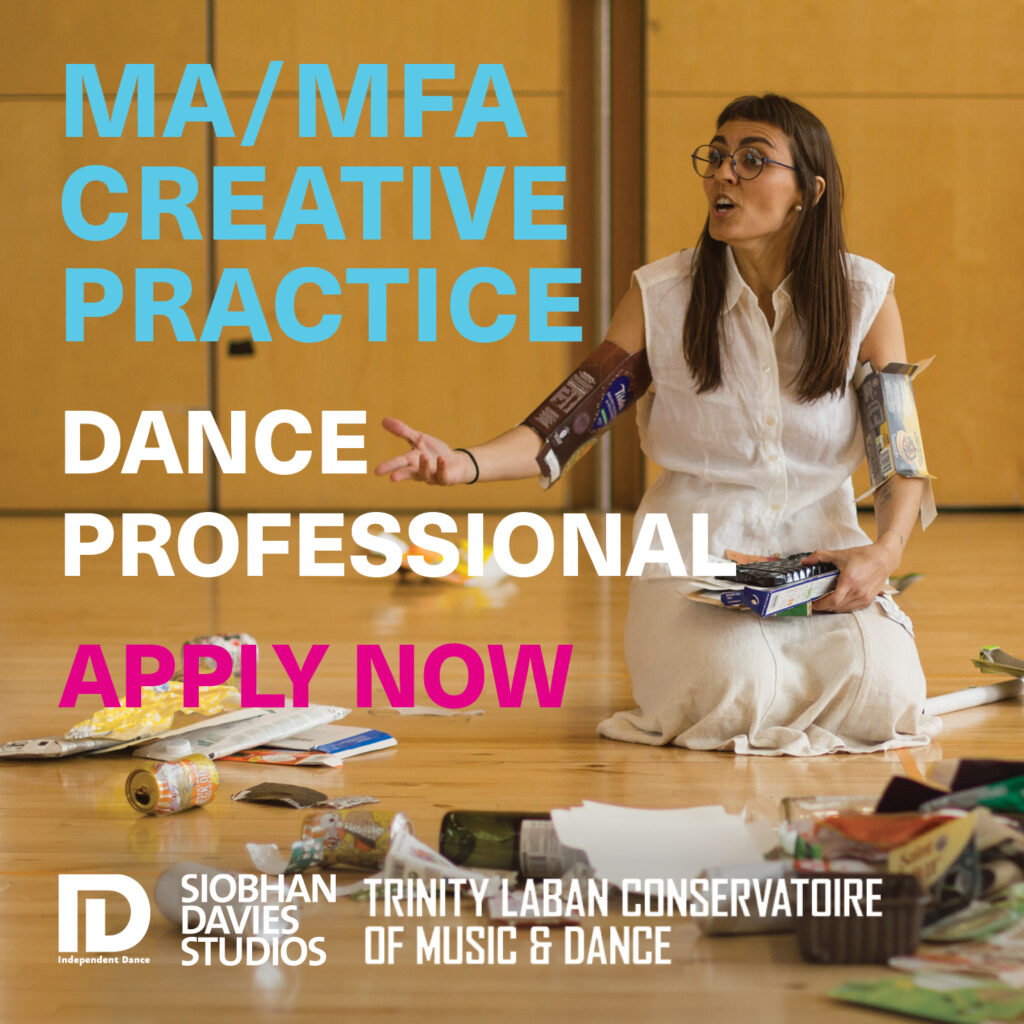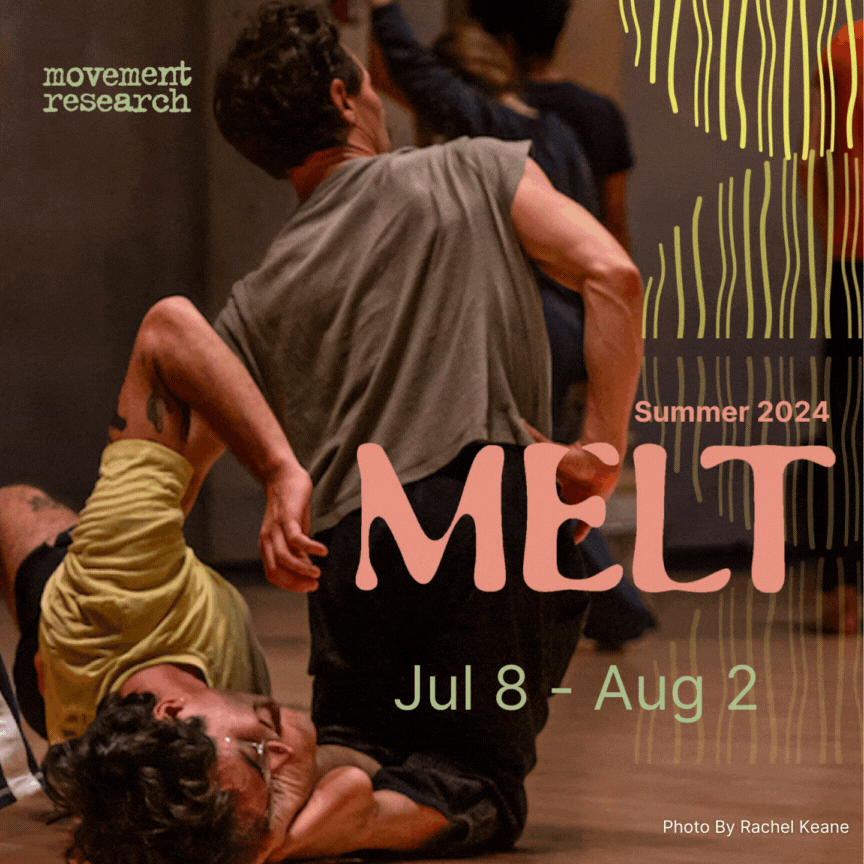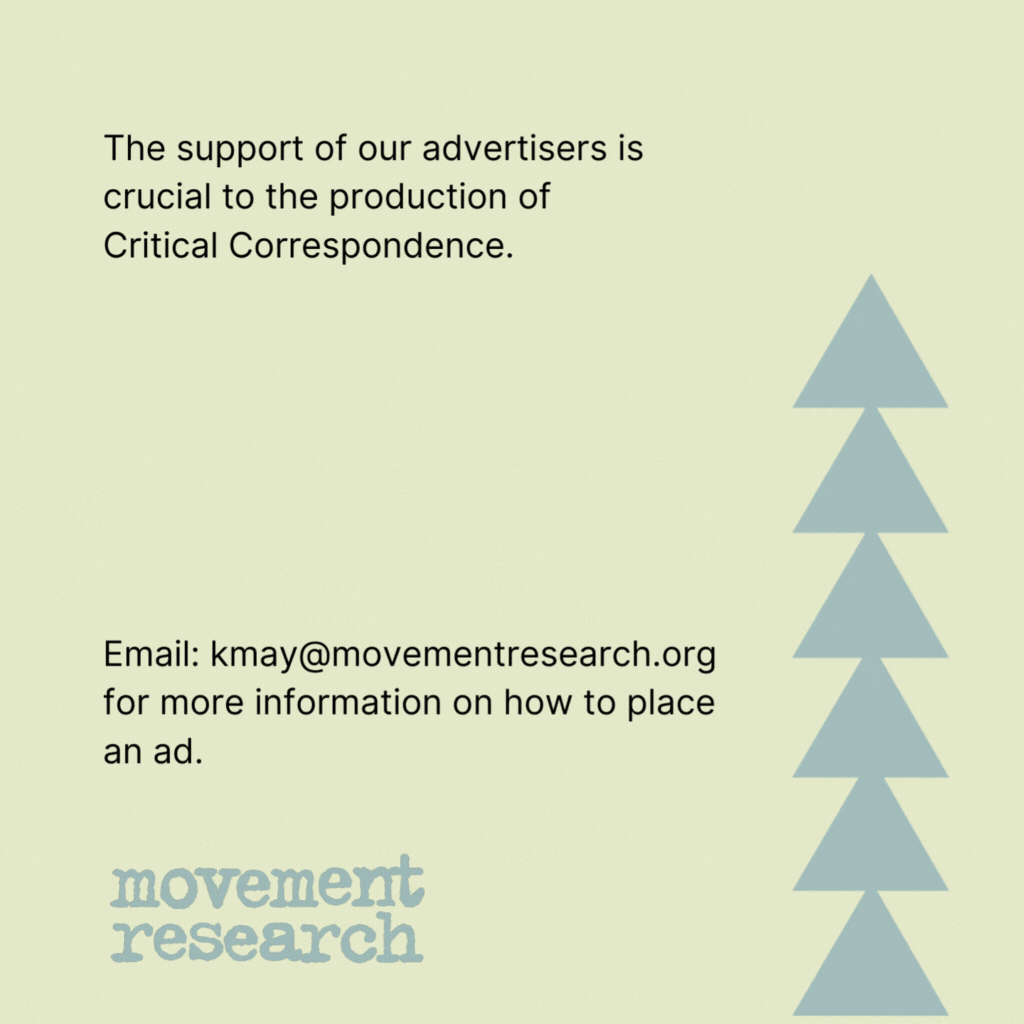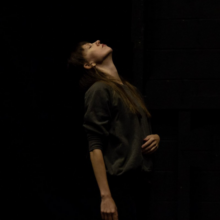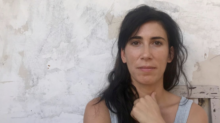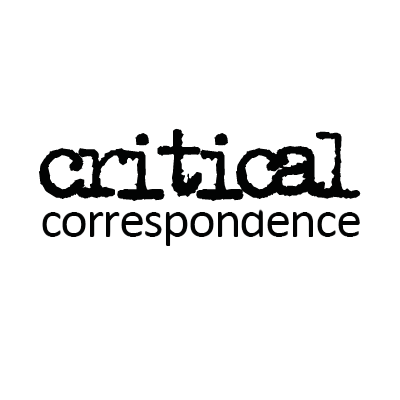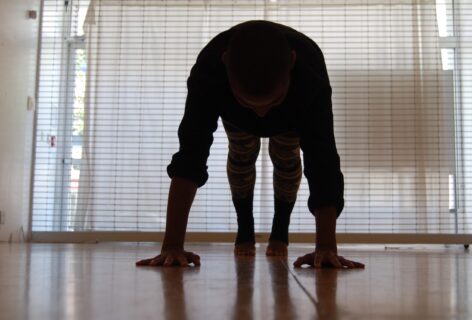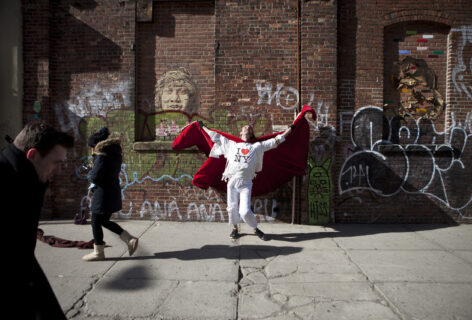The original article, Dancing in Palestine, can be accessed at this link. All additions to the original article are indicated in bold and aligned to the right. The original interview was conducted in 2011, the updated dialogue is from 2023.
Katie Schetlick interviews Samar Haddad King, artistic director of Yaa Samar! Dance Theatre, a New York dance theater company. They discuss King’s exploration of Palestinian identity and family history in her new work, which is being made with a group of dancers at the Ramallah Contemporary Dance Festival in Palestine. This is the third and final interview in a series initiated by Schetlick, documenting her experience at the festival.
12 years and one day later, Samar Haddad King and Katie Schetlick revisit their conversation from December 14, 2011. Samar recently completed a tour of Losing It with Samaa Wakim in Western Europe. Two days prior to revisiting this conversation, Freedom Theatre’s Ahmed Tobasi, with whom Samar and Samaa shared a bill in France, was detained by the IDF and beaten, their theater space and school in Jenin ransacked.
Katie Schetlick: How are things going over there with the development of your new work?
Samar Haddad King: It has taken me a bit to get going. My mind is still wrapped up in the last piece, Bound.
Katie: Did you go in and teach a class first? How did you start the process?
Samar: I started with a rehearsal but I am teaching them ballet actually. They have had ballet training before but it came from the school of “squeeze everything.” A lot of them have knee problems and I think it is also because of their dabke [traditional Palestinian dance] training. A large part of teaching is a matter of helping them deal with injuries that may have happened years ago.I have divided them up into groups for rehearsal and the piece is sectional for the time being. It varies from rehearsal to rehearsal who will be in attendance since they too have lives outside of the studio, school and work, and they are not being paid for their time here.
Katie: Looking back on this conversation more than ten years later, what has shifted or remained the same about the physical practices that support or challenge your work?
Samar: (One thing I want to correct is that the knee problems weren’t because of Dabke training. I think a lot of it had to do with certain floors. There’s a lot of stomping and it’s a lot of force going into the ground and sometimes just doing it on concrete floors over a number of years, well, that was one of the issues. But I didn’t mean to imply that Dabke training itself is bad for your body. )
Yeah, there’s a big shift because there’s history now. Most of the artists that I’ve been working with, in Palestine, it’s now been a decade plus, in New York, almost two decades. Because of this shared time a lot of my work deals with building a universe together, building the rules that define that, give some kind of order to this universe. And, of course, when we break those rules, that’s the fun part.
I think a lot of the artists don’t care about steps anymore because a lot of them have actually developed their own practice. They have developed their own movement style and so they’re less looking to move like someone else. I still give movement though, that’s been a part of my practice from day one. I mean, we often work with unison phrases. I actually work with a lot of unison; I don’t know what that’s a product of… Maybe it’s a product of the more folkloric forms making its impression on my contemporary form? I don’t know, the power of the group has always been so inspiring for me. And then the various small differences that you can see in people.
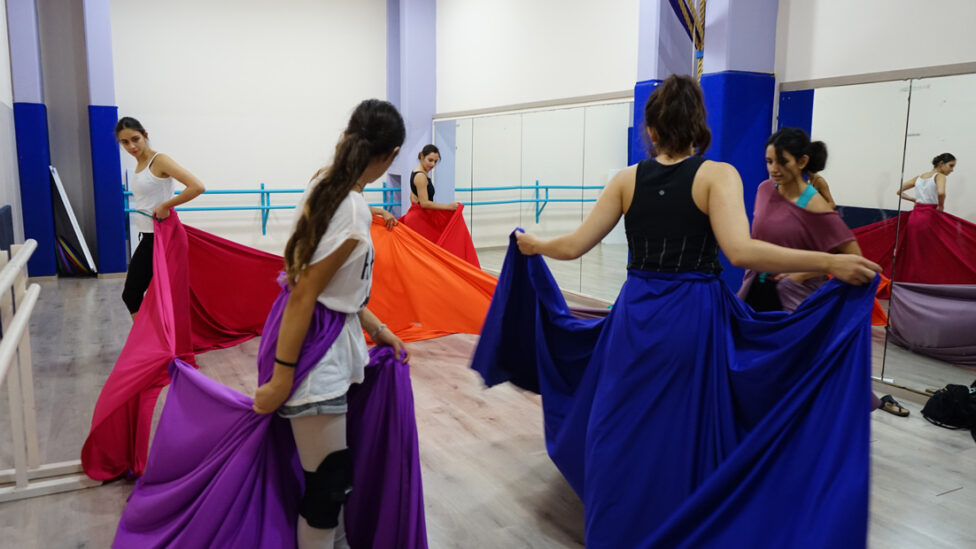
Photo courtesy of Yaa Samar! Dance Theatre
Katie: Did you go in with a rough idea, knowing the rehearsal time would be sporadic?
Samar: I did. I went in with three undeveloped ideas and one started speaking to me more. We are dealing with memory. 1948 [the year of Israel’s birth and the simultaneous expulsion of over 700,000 Palestinians from their homes] is still largely on people’s minds here, my mother included. Many people who were born before 1948 are still living, so that memory is still very much alive. A lot of people currently living in the West Bank aren’t originally from the West Bank. They are from what is now Israel. So, since 1948 there has been this issue of displacement. I mean it is obviously now a large aspect of the Palestinian identity: the displacement. You see it in the folklore and even the contemporary art.
I was interested in all of this at an early age just from hearing conversations in my family—I remember asking my aunt, “Did Taita [grandma] accept Jordan as her home?” And my aunt, without hesitation, said, “No.” She always felt like she was going to go back to where she was from one day, which was Palestine. That refugee idea resonates highly with many Palestinian families. The piece is dealing with an older person who doesn’t live here [in Palestine] anymore, who has flashbacks of himself and his wife.
The flashbacks aren’t necessarily linear or entirely factual. There is randomness in memory and what you remember. I am structuring it more through an actual narrative from the perspective of one, a grandfather, and the ideas he is sharing with his grandchild about these memories. In the story the grandfather dies and writes the grandchild a letter and basically says, “I need you to take my ashes back to my wife and back to my land. I need you to spread them.” In actuality, this is highly unlikely since cremation isn’t practiced or widely accepted in the Arab world. I am hoping to push these ideas of truth in the story, to put pressure on notions of fiction and non-fiction and on ownership of the “right” memory.
Katie: What strikes me most about this moment in the conversation was the need at the time to simply articulate some basics of a common Palestinian experience for an audience that might have little to no knowledge about what happened in 1948. The current moment has seen some increase in awareness of this history and it has become astonishingly clear that these practices of displacement and erasure never really stopped. Has this moment affected what stories you would like to share through your work and how you share them?
Samar: I don’t know if I’m a one trick pony. I was like, oh yeah, that piece, من الغبار “From Dust” is exactly the piece I’m about to build for the Shed premiere next summer. It’s not the exact piece, but it is dealing with erasure and we’re now dealing with it more than ever. We are not just talking about people getting displaced. We are talking about tens of thousands murdered and the after effects of this current war, disease, and famine—murdered hopes, murdered resolve. I mean, I believe that we have strength, something about being denied a homeland, it’s taken from you and then you are denied the right to return. We have a very strong thread that binds us Palestinians together and this current work deals with these concentric circles and space being taken away. Who gets to come along? What do you get to keep? I think there’s a physical idea of what you get to keep and also an emotional idea of what you get to keep. من الغبار “From Dust” was talking about the Nakba through the lens of a granddaughter talking to her grandfather. The man who did the voiceovers, Karim Dabbah, has since passed. He was a well-known visual artist in Palestine and the father of a dear friend. He’s passed, he has his artworks that still hold his memory. I still have his voice recordings too. But as the populations that were alive during the Nakba and remember it are passing away, we felt, and continue to feel, this pressurized time to retain these memories.
We know erasure well, but what we are experiencing now: not only are whole families being erased, but there are so many new laws all over the world dictating what anyone is allowed to say; and when we are unable to open our mouths and express solidarity, to fight injustice, when people are getting attacked or become too scared to resist this silencing, it will lead to more erasure. I think there’s a choice when there’s so much to deal with about what you retain, what you keep and what you don’t keep and what you value, what has higher value. Obviously, human life should have the highest value, and that’s the thing that’s sacred. And I think for all of the work that I do, it’s valuing that human life is sacred. Art is not sacred, sorry. Human life is, and for me, part of this telling of stories, whether they’re fictitious or not, is a part of resisting this erasure—watching people be relentless in their fight for life. We’re seeing that every day in real life. And I think those are the stories I want to share because it’s the vigor, the relentlessness.
The moment has affected me severely, like you’re seeing it happen. We’re watching. I remember when I first saw the picture and then the video that came out of Gazans fleeing south on foot, my knees got weak and I said, fuck, it’s happening again. I’m about the same age my Taita, my grandmother, was at the time of the Nakba in ‘48. And I am thinking, what, this is happening again and the world is letting it happen? And it feels unbelievable. It feels unbelievable.
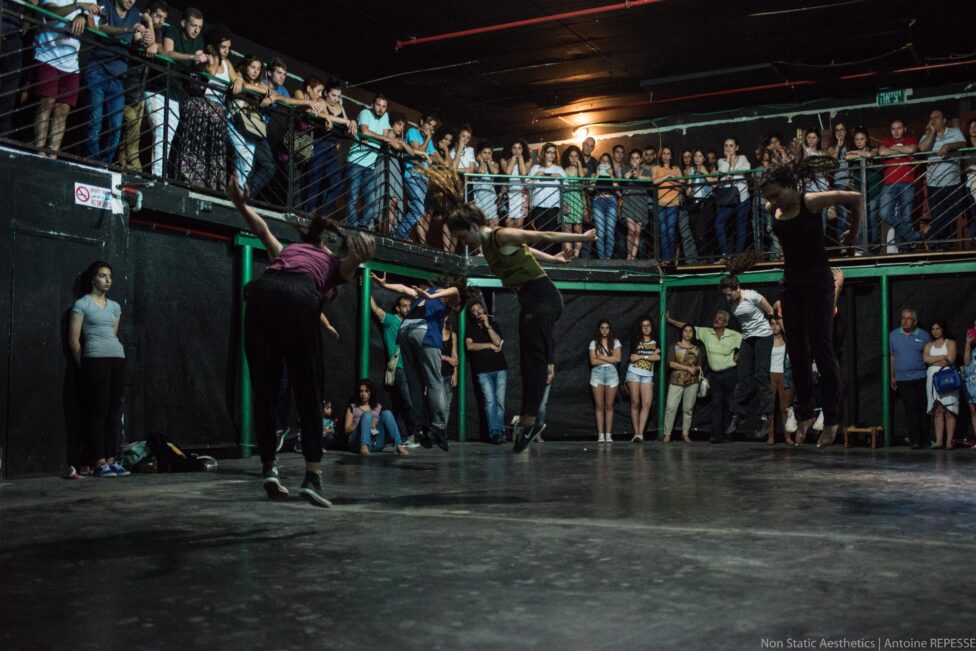
Photo by Antoine Repesse, courtesy of Yaa Samar! Dance Theatre
Katie: Thinking about these notions of story and truth, when you went into the studio did you share your family’s story and your history with the dancers?
Samar: I did and I didn’t. I kind of told them in waves. I talked to a few of them about it, but it’s a two-fold thing, the sharing and creating. With [a previous work] Bound, we started with writing stories pretty early on. I have been working for about a month and I haven’t been writing intensely; we are still keeping it quite physical.
I can feel from [the dancers] that there is this push—they want me to teach them steps and not just have them do task oriented things. Which I understand. When you are learning and training in many styles then you have more freedom to break from them. But when you have never had a main style except for folkloric then you crave the material of something else to guide you almost like a place to jump from or a language. And they are not interested in bringing the folkloric to their work as a basic language. They believe, which I believe too, that to try and keep the “Palestinian-ness” of their art through sticking to the old ways will box them in—it [their “Palestinian-ness”] is going to be there by nature of who they are no matter what they do. You know like what they said in a Facebook discussion they had with you, it is not necessarily about being Palestinian and showing the world that Palestinians can dance. For them they just want to f****** dance.
For me, because I have departed from that way of working [of giving steps], it has been a big challenge. I am not used to going in and creating movement. I am used to working off of people. Of course, I am working off them as we are creating steps, but it is different. Like with anything and with any new process, I have had to adapt. If we are stuck we stay stuck and just breath until we figure it out. Sometimes we just don’t try to push it and then the next day something comes.
When I come back [to Palestine] I think we will start incorporating more writing. Because of their folkloric training there is already a connection to narrative in their bodies. But embodying a specific character is much different than portraying a folkloric tale. With each person having a solid identity in this piece, developing that individual identity will be the next step.
Katie: It’s notable the way you expressed the need for each performer to develop an individual identity after articulating the frustration of several dancers in Palestine that they are expected to dance their “Palestinian-ness” as though Palestinian identity is monolithic. Have you continued to mobilize storytelling in your work as a way to disrupt this?
Samar: Yes, storytelling, individual stories– I’ve always found it to be the way to have the performer make specific choices. I think I’ve departed a little bit from more reflective, memoir-like writing and have started writing from the perspective of particular roles—the doctor, the cleaner in this hospital, the baker, the fifth grade elementary school teacher— like in the more recent work, Last Ward, created with a frequent collaborator of mine, Amir Nizar Zuabi.
In the new work I’m building, there’s quite a large text. It’s a fictitious story loosely based on a real person. I have the artists answering prompts within the world of their character and in the world that we’ve built. Of course the specific choices the performer makes are influenced by their histories and their past and their Palestinian-ness or since I work with artists across the globe, wherever the artist might be from: Turkey, Japan, the U.K., Detroit, Vermont. I believe that all of the ingredients of all of their lives, yes, will influence these things, but we do approach it from this third person, a fictitious character.
Oftentimes, working in fiction allows an artist to really explore depths that maybe if they’re just taking their own story, they might be afraid to tap into it fully. Our job with the stories is to deliver something, a portal for the audience to maybe see a reflection of themselves or to walk through a door and see something else.
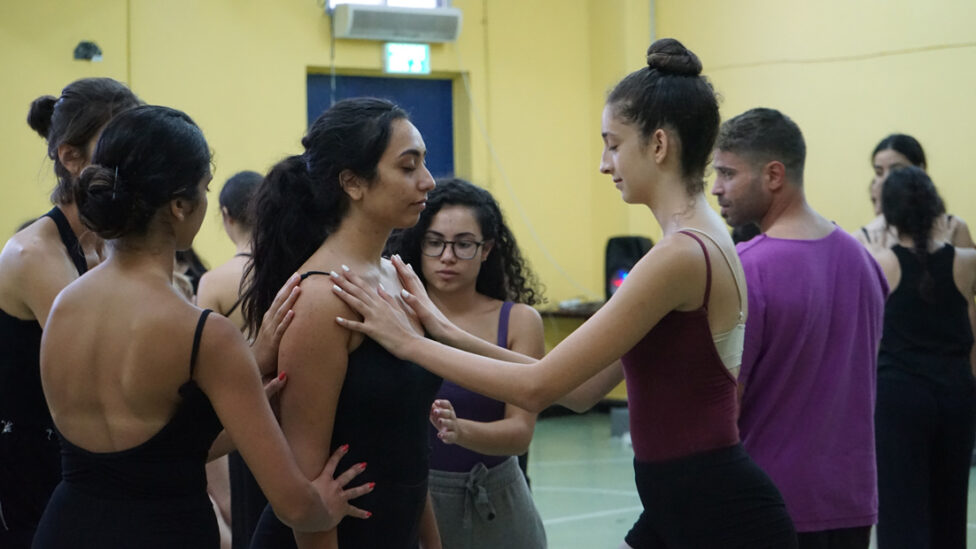
Photo courtesy of Yaa Samar! Dance Theatre
Katie: Will there be text involved like in your other works?
Samar: Yes, there will be voiceovers but I don’t think there will be video involved.
Katie: Is the work being created for a particular performance with a specific audience in mind?
Samar: Yes, it is for the festival [Ramallah Contemporary Dance Festival]. It is exciting to work with them [the dancers] on something that has become so important to the development of dance here. I know them and have known a few of them for several years, so they are not random people. They are close to my heart and I know their stories and the simple fact that it is not easy doing contemporary dance here, which actually has nothing to do with religion. It has just to do with the same thing in the West—“What kind of job are you going to get with it?” “How will you take care of yourself?” Those things that parents are more worried about. Dancing for a living is not an easy thing anywhere but dance for most Palestinians has largely been experienced as a part of their celebrations and gatherings. To try and explain to parents—or society at large—that dance can also be a meaningful profession is a challenge.
I always thought my work was quite accessible to non-dancers and a non-arts crowd, so I am hoping that this will be one of those pieces that people will be able to relate to in some way. I have an interesting perspective because I grew up in the south, in Alabama, with a Palestinian mother. Traveling back and forth to Palestine to visit my family as I was growing up had a profound effect on the way I see things and obviously living here now does too. I can’t say that I am exactly like the dancers here because I grew up quite differently from a lot of them. But we have so many shared values through art and dance. It is nice to shape the work with them as someone coming from outside and inside.
Katie: There is already a level of trust there. A platform to begin a dialogue, if you will.
Samar: Exactly. It’s super inspiring for me because they don’t just settle for what is there. They do not allow me to fall back into my comfort zones or safety spots. We have been playing with working with very little so we can see how far the possibilities can stretch and where they might lead us. We will see what happens.
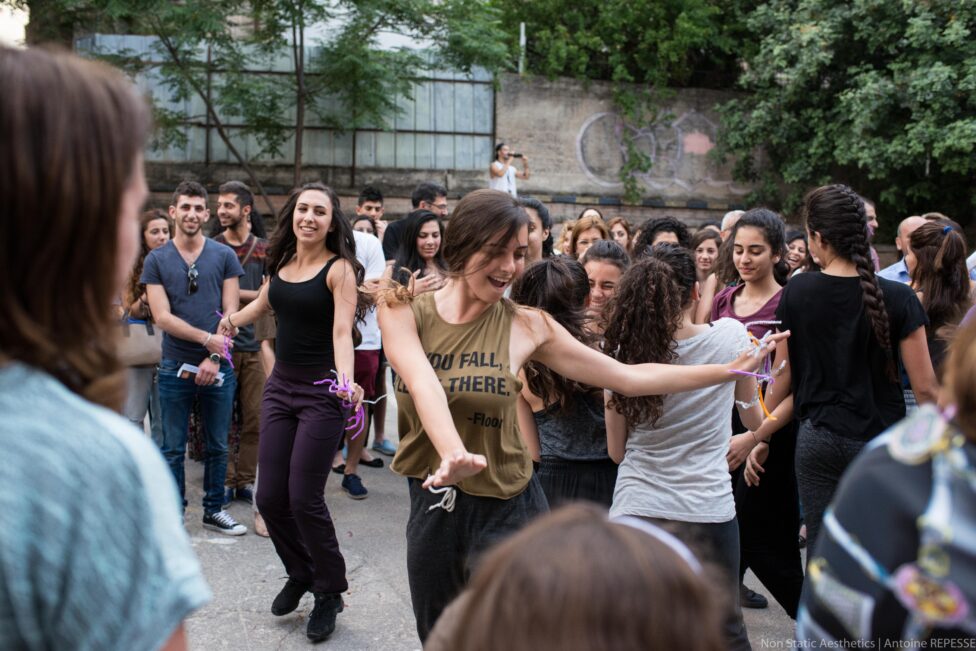
Photo by Antoine Repesse, courtesy of Yaa Samar! Dance Theatre
Katie: What did happen? How was the work received? Where are those dancers now?
Samar: What did happen? (laughs) Well, it was funny, there’s a scene in it where someone is making a cake, and the ta7in , the flour, that I purchased was Israeli flour. When I bought it the Arabic side was facing out so I didn’t notice. In the West Bank, there’s a lot of Israeli-made products sold there even though there are Palestinian-made equivalents. On stage the performer placed it so the Arabic was facing them, which means the Hebrew side was facing the audience, so after the performance there were many inquiries of ‘what did you mean by that’ or ‘why didn’t you buy the Palestinian equivalent’. Myself, nor anyone in the cast noticed. But it’s all in the details right. Then there was a larger discussion, was I trying to make a point in how the economies are linked? Was I trying to comment on the fact that if we don’t pay attention to detail, we inadvertently will add to our own erasure? It was a detail overlooked (that shouldn’t have been perhaps), but became quite the post show discussion for some.
I also remember there was a presenter from Eastern Europe that was there and really did not have great reactions to the work. She had a very particular way of viewing art in conflict zones and this idea of, well, what happens when the wall falls? And I was like, well, I think we’re far away from that still.
I am not giving and don’t want the audience to take an exam. If you want to learn about Palestine, there’s a plethora of books that I can give you that will teach you the history. You’re not going to get it in a work of mine. You’re going to get fragments of it. Tastes of it. You’re going to get interest in it (hopefully!). You’re going to feel moved by these characters on stage (if I do my job well), but are you going to learn all the facts? No. And that’s not my job. And so this woman, I think had a really big, negative response to kind of doing anything that was responsive to living under occupation, which I felt was coming from a very privileged place. These people are living, we’re still living the past, the present, and the unknown future and adapting, and we’re thriving even when they’re sucking our life from us!
But she also didn’t like the movement quality in it. I think some of the partnering work was absolutely beautiful because it was created with the two bodies that were in front of me. And she got really angry (She was a very vibrant woman). I looked at her and I said, I think you’re missing the point. For now, this is what these artists wanted, first of all, and these artists are hungry to express themselves, and it’s my job if this is what they’re curious about. It doesn’t matter if it’s a success or failure on some weird Western scale of what’s good art and what’s bad art. For this, it was the process and there was huge growth from the beginning to the end. And it spoke to the local audience which for me is always priority.
She wasn’t there when our artists performed in Jerusalem, which for some of the artists was the first time they had ever performed in Jerusalem, the capital, because of the checkpoints in between and their id status preventing them access without permission from the Israeli authority. A lot of them had West Bank IDs and had to go through checkpoints and had to be humiliated, their dignity stripped from them again– strip searched. I remember one of the performers, Adel, he just sat and cried before the performance. He was well into his thirties, but it had been a long time since he crossed a checkpoint. He had never had permission to do so and just was so beaten down, crushed. In the performance, there’s a checkpoint scene, and I remember watching him. He was very soft spoken and so angry, and it looked as if he was being manipulated by someone. I mean, you really saw the person, you really saw him being thrown around. Am I glad that he went through that experience and that humiliation and that fear and all of that? No, I don’t want these artists to have to live this. They’ve lived a whole life of this. But I think there was something about these artists’ current experience and their history that in that moment it was what they needed and what they wanted to express.
Am I building works like that now? No. With the artists in Palestine, no. The worlds don’t seem, at least the aesthetic, doesn’t seem as imposed. I have used a lot of Dabke in the work since then. I feel like Dabke has in some way been a part of every show in the past 8 years, and in a lot of the workshops that we teach. There’s something so beautiful about it for me. It brings me joy and I’m not good at Dabke, but there’s a freeing sense to it. And when the Palestinian artists in the company use it, they exude so much with it, so much strength that it’s like how can that not be a part of the repertoire, a part of our vocabulary? It is.
As for where the artists in that work from 2012 are, some are living in Europe, still working in art. Some have left the art scene and are working in marketing. A lot have left, a lot have left. And no, I don’t think anyone wants to leave here. It’s our home. But the circumstances in a lot of places have, I think, driven people down.
But what will happen in the future… we keep trying, we keep trying.
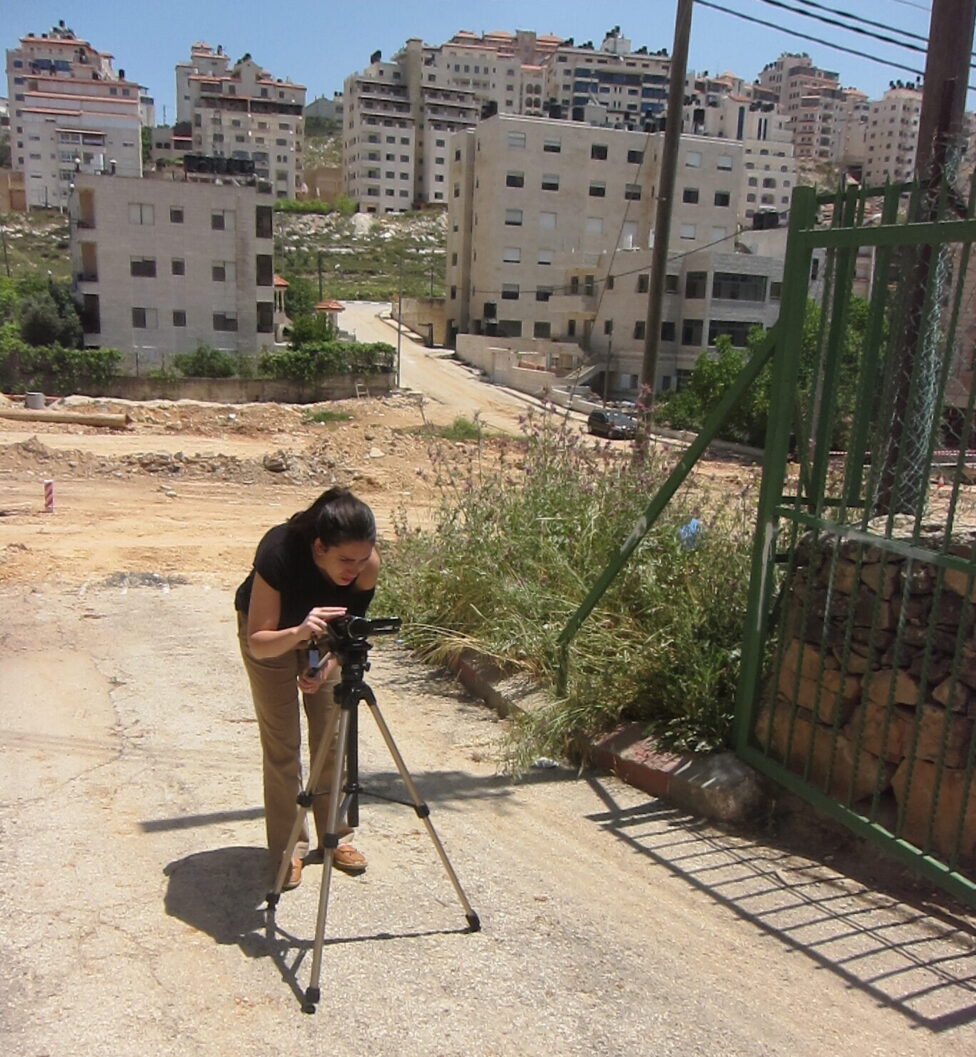
Photo of Samar Haddad King by Katie Baer Schetlick, 2011.

